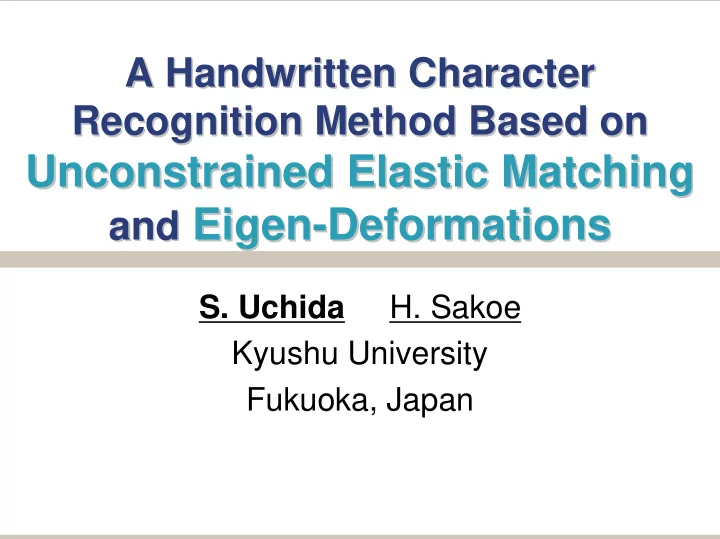

A Handwritten Character A Handwritten Character Recognition Method Based on Recognition Method Based on Unconstrained Elastic Matching Unconstrained Elastic Matching and Eigen Eigen- -Deformations Deformations and S. Uchida H. Sakoe Kyushu University Fukuoka, Japan
Elastic Matching (EM) Elastic Matching (EM) displacement deformation-invariant field distance reference input warped reference 2 Human Interface Lab. Kyushu Univ.
Unconstrained EM Unconstrained EM � A classical EM method � Based on individual & local optimization of the displacement at each pixel � High speed & high flexibility ! � ... but, rarely employed ! (slower and less flexible constrained EMs are often employed). 3 Human Interface Lab. Kyushu Univ.
Overfitting by Unconstrained EM Overfitting by Unconstrained EM similar! input reference “gap” discontinuity (neglected in evaluation) similar! reference input 4 Human Interface Lab. Kyushu Univ.
Purpose and Key Idea Purpose and Key Idea � Purpose Revive unconstrained EM by relaxing the overfitting problem � Key Idea Detect overfitting as the deviation from eigen-deformations not eigen-deform. eigen-deform. 5 Human Interface Lab. Kyushu Univ.
Two Tasks Two Tasks � How to estimate eigen-deformations ? � How to use the eigen-deformations in recognition process to detect overfitting ? 6 Human Interface Lab. Kyushu Univ.
Estimation of Eigen- -Deformations Deformations Estimation of Eigen eigen-deformations collection of displacement fields using unconstrained EM … Principal Component Analysis … … reference training patterns 7 Human Interface Lab. Kyushu Univ.
st Eigen Estimated 1 st Eigen- -Deformations Deformations Estimated 1 「 A 」 「 B 」 「 C 」 0 apply apply (reference) positively negatively 8 Human Interface Lab. Kyushu Univ.
Recognition Using Eigen- -Deformations Deformations Recognition Using Eigen input reference image eigen-deform. of “A” disp. field distance … + Mahalanobis min dist. distance discrimination 9 Human Interface Lab. Kyushu Univ.
Recognition Rates Recognition Rates with eigen-deform. 1 0 0 99.07 ( proposed ) recognition rate (%) for 500samples/category 9 8 without 9 6 eigen-deform. ( conventional ) 9 4 degradation due to overfitting 9 2 0 1 2 3 4 5 maximum displacement (pixels) 10 Human Interface Lab. Kyushu Univ.
Unconstrained vs. Constrained (1) Unconstrained vs. Constrained (1) 1 0 0 0 computation time (ms) constrained 1 0 0 unconstrained 1 0 1 0 . 1 0 1 2 3 4 5 maximum displacement (pixels) 11 Human Interface Lab. Kyushu Univ.
Unconstrained vs. Constrained (2) Unconstrained vs. Constrained (2) without with eigen-deform. eigen-deform. unconstrained 98.35% 99.07% constrained 99.12% 99.43% Unconstrained EM (fast) is comparable to constrained EM (slow) in recognition rate when eigen-deformations are used 12 Human Interface Lab. Kyushu Univ.
Conclusion Conclusion � Practical recognition method based on unconstrained EM � Eigen-deformations to suppress overfitting � Experimental results enough to encourage the revival of unconstrained EM 13 Human Interface Lab. Kyushu Univ.
Mahalanobis Distance Mahalanobis Distance M Σ 1 〈 v - v , u 〉 λ c c,m c,m m =1 v : displacement field to be evaluated c : class (“A”, “B”, ..) of reference u c,m : m -th eigen-deformation of class c λ c,m : contribution (eigenvalue) of u c,m 14 Human Interface Lab. Kyushu Univ.
Piecewise Linear Unconstrained EM Piecewise Linear Unconstrained EM input reference linear interpolation variable fixed the mapping of each column is optimized INDEPENDENTLY 15 Human Interface Lab. Kyushu Univ.
Probable Overfitting Probable Overfitting cross (fold over) gap (skip) 16 Human Interface Lab. Kyushu Univ.
Data Data English capital letters from ETL6 (1100 samples / category) preprocessing (size normalization, blurring, histogram equalization…) #1-100 #101-600 #601-1100 average reference training patterns test patterns 17 Human Interface Lab. Kyushu Univ.
Misrecognitions Reduced by Present Method Misrecognitions Reduced by Present Method “L” “U” misrecognition due to “gap” “F” “P” “N” “M” 18 Human Interface Lab. Kyushu Univ.
Recommend
More recommend